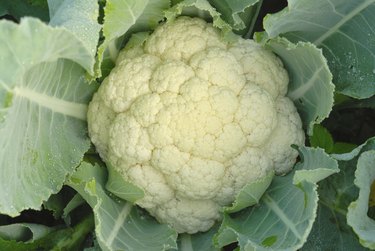
If your vegetable garden is constantly wet, growing vegetables that thrive in very moist soils improves your chances of success. Excess water causes rotting and encourages root diseases in most vegetables, but varieties that were originally aquatic or marginal plants thrive in moist soil. Slugs and snails also love moist soil, however, so go on patrol after dark or before dawn with a flashlight to find and remove these annoying pests.
Watercress and Taro
Video of the Day
Vegetables that thrive in waterlogged soil include watercress (Nasturtium officinale) and taro (Colocasia esculenta). Hardy in U.S. Department of Agriculture plant hardiness zones 5 through 11, watercress grows best in slowly moving water about 2 inches deep, but can thrive in waterlogged soil in a shady location.
Video of the Day
Growing 20 inches tall and 39 inches wide, watercress sprouts new plants where its leaf nodes touch the soil and can be harvested year-round. Taro is a perennial vegetable in USDA zones 8 through 11 and grows 3 to 6 feet tall and wide. Thriving in water up to 6 inches deep, taro provides edible tubers, shoots and young leaves.
American Ground Nut and Arugula
Constantly wet roots don't affect American groundnut (Apios americana) or arugula (Eruca versicaria). A perennial climbing plant, groundnut is hardy in USDA zones 4 through 9 and grows up to 4 feet tall. Edible tubers appear along its long, thin roots, which take two years to grow to a usable size.
American groundnut bears brown, bronze or maroon spring flowers and can be invasive in its favored moist conditions. Arugula is an annual vegetable that provides salad leaves and edible flowers. Grown from seed sown in winter or early spring, arugula grows 24 to 36 inches tall and 12 to 18 inches wide and can self-seed around the garden.
Celery and Garden Pea
Some vegetables only grow steadily and healthily in permanently moist soil. Celery (Apium graveolens var. dulce) grows best in full-sun sites and rich, constantly moist soil. Usually grown as an annual plant, celery is a perennial that's hardy in USDA zones 3 through 6 and is invasive in some areas.
Another plant that thrives in constant moisture is garden pea (Pisum sativum var. sativum). An annual vegetable, garden pea provides edible pea shoots as well as peas in their pods. Although garden pea grows well in moist soil, pea seeds rot in cold soil, so wait until late spring before sowing or sow smooth-seeded varieties, which resist rotting.
The Brassica Family
Vegetables in the brassica family grow best in moist soil that never dries out, although they don't tolerate soggy soil. To form large, firm heads, cauliflower (Brassica oleracea [Botrytis Group]) requires constantly moist soil, and related plants, such as cabbage (Brassica oleracea [Capitata Group]), also thrive in moist conditions.
Brassicas are grown as annual, cool-weather plants. They can't tolerate heat or drought and are usually sown during early summer and ready for planting out during late summer or fall. Because brassicas suffer from a range of soilborne diseases, they should be planted in a new site each year.
- Plants for a Future: Nasturtium officinale
- Missouri Botanical Garden: Eruca versicaria subsp. sativa
- Missouri Botanical Garden: Colocasia esculenta
- Plants for a Future: Apios americana
- Missouri Botanical Garden: Brassica oleracea (Botrytis Group)
- Missouri Botanical Garden: Pisum sativum
- Missouri Botanical Garden: Apium graveolens var. dulce